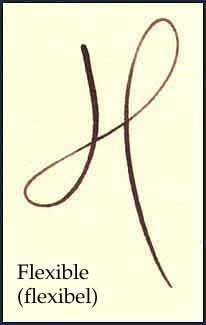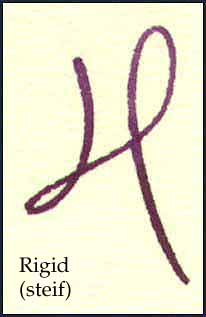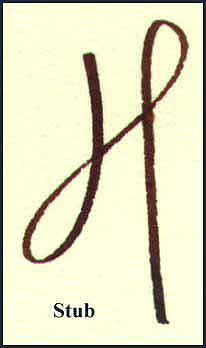

 |
The whole point of a flex nib is in the line it puts down on paper. From thick bold downstrokes, to spiderweb thin lines, the flex nib will give you a wide range of line thickness to work with when you write. The trouble is that a flex nib can take some getting used to, definitely if you are just getting used to fountain pens, and even if you have experience with modern pens. A gentle hand is vital as you start in, it takes a while to get the feel for a given flex nib. Once you develop this feel, you can adjust the amount of pressure you put on the nib as you write, and you will begin to see the effects in your writing. As you can see on the left, the flex nib gives a much more delicate line, even on those portions where the tines were flexed fully, putting down a thick line. The most common term for the effect of a true flex nib is "shading", and it's easy to see why! |  |
 |
You can achieve some of the attributes of a flex nib, namely the thick/thin line, by going with a stub or italic cut nib, which relies upon the shape of the nib tip to provide the line characteristics. While this will give a wide line on the downs stroke, and a thin line on the side stroke, it will have none of the "shading" effect of a flex nib. The line width is changed due to the shape of the tip, the ink flow remains the same. Thus, there is no change in the tone of the ink, and the shading is lost. Still, in many cases, the stub nibs can be useful, being much easier to use in a wide range of circumstances. One of the drawbacks to a flex nib is that using it requires attention, even after you become fully accustomed to the nib. It's not the right choice for taking hurried notes in class! I use my flex nibs mostly for letters or notes to friends, where I have the time to concentrate on what I'm doing. The extra time pays off in a wonderful improvement in the way my handwriting looks. When I know I'm likely to be jotting things down in a hurry, I will chose a rigid nib, or, at least a stub nib, so I can concentrate on what I'm writing, not how I'm writing it. Now that we know what a flex nib is, and what it's used for, and even how to identify one, let's get down to brass tacks.... Where can we find these paragons of pendom? |
I suppose we should start with an attempt to settle the vintage versus modern flex debate. It's by no means the last word on the subject, but my humble opinion, after searching high and low, is that you should buy vintage if you want a "real" flex nib. Having made this statement, though, I have to hasten to add that you may not want a "real" flex nib! Flex nibs are, as I have mentioned, touchy, not the easiest nibs to use, and can be impractical. You have to decide if these drawbacks add up to deter you form a flex nib.
Many modern pens have what most collectors call "soft" nibs. That is to say, the tines will spread apart as pressure is applied, and many are not rigid in this regard, but they lack the same shaping of the iridium tip as vintage flex nibs, with the rounder ball tip, they are smoother, but they lose most of the shading. This is not to suggest that they are bad nibs, however! Modern Pelikans have some of the best nibs currently made, and they have this "soft" nature, that makes them a real pleasure to write with. The M1000 is among my favorite modern pens for this very reason. Compared to a lot of modern pens, you would say it had a flexible nib, it's only when the comparison switches to vintage flex nibs that the difference becomes obvious. The modern nibs, as best as I can describe it, have a flexible feel, even if they are not acting in the same manner as vintage flex nibs. I definitely prefer them to a rigid nib.
If you want a good modern "soft" nib, aside from the Pelikan M800 and M1000, I would also suggest looking at the Namiki Falcon, a pen that has been specifically designed to have a flexible nib. While not a "real" flex nib, it's very good, and they are nice writers, with a very up to date modern look. Stipula is another company that makes excellent "soft" nibs. I especially like those on the Etruria and the Nettuno Superba. If you can find an OMAS with the 14K nib, these are very nice, getting very close to vintage flex nibs in the fine point versions. The last I checked, OMAS was still refitting pens with this nib on a special order basis. Even the lowly Parker Sonnet has a very nice soft nib, as does the Sheaffer Balance II. If you get an example of either of these somewhat troubles lines that writes well, you should be very well pleased with the feel of the nib.
If you've decided that nothing but a "real" flex nib will suffice, then your search will lead you into the world of vintage pens. While there are some famous pens that are known for their flex nibs, you really don't have to spend a fortune to get a good flex nib pen. The flexible nib Doric and Deco Band pens from Wahl Eversharp, or the Waterman Hundred Year pen are nice, and can make for stunning collections, but they do tend to get pricey! However, you can find truly excellent flex nibs on relatively humble pens from these same companies. Try a Wahl Eversharp Skyline, or a Waterman 52, both of which, in plain, everyday models, in "user pen" condition, should be about $50, ready to write, and with a little looking, can be found with great flexible nibs. Do be sure to check the nib, though, as not all of these models came with flex nibs!

Don't limit yourself to the "big four", either! In the first place, both Sheaffer and Parker, although they did make flexible nibs, particularly on their earlier pens, are better known for more rigid nibs. In addition, it's always nice to save a few dollars..... Many of my favorite flex nib pens have been "no-name" pens, from smaller manufacturers. While not as well known, or valuable as Waterman's and Wahl Eversharps, these pens can be great writers. They key is to try the nib before you buy! I find that pen shows are best for this kind of shopping, getting the pen in your hand, and either dipping, or even just seeing how the nib behaves dry is a great help. Online buying can be managed, but it helps to be buying either from an experienced dealer who correctly labels their pens as to nib flex, or who has a liberal return policy.
Once you try a flex nib, you may decide that it's just not for you. You may, like me, decide that it's very much for you, but only under certain circumstances, and direct your search accordingly. Or you may, like one friend of mine, decide that flexible nibs are the only "good" pens, and write with nothing but a flex nib! In any case, you owe it to yourself to at least give one a try, and join in all this flex nib fun.
For questions or additions please write to: dethardt.baumann@mus.ch